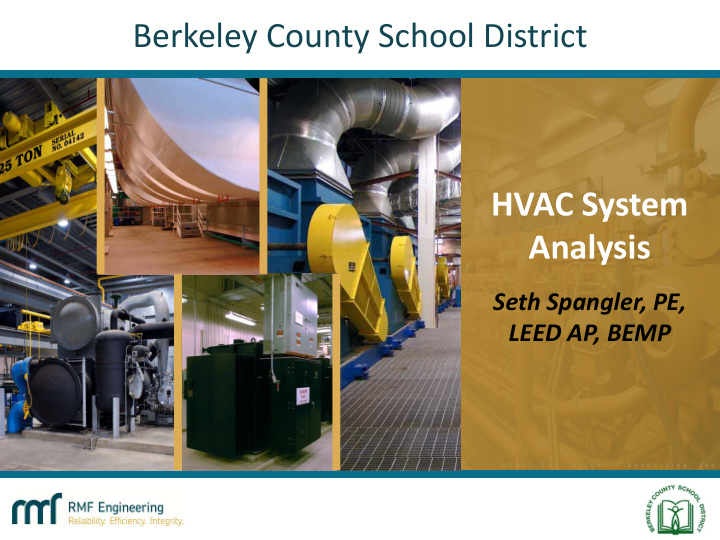



Berkeley County School District HVAC System Analysis Seth Spangler, PE, LEED AP, BEMP BCSD HVAC System Analysis
Introduction » Seth Spangler is a licensed Professional Engineer and American Society of Heating, Refrigeration and Air-Conditioning Engineers (ASHRAE) certified Building Energy Modeling Professional who designed both the Cane Bay Middle School and Timberland High School Heating, Ventilation and Air Conditioning (HVAC) systems. » RMF is a 230 person consulting firm specializing in building and infrastructure systems engineering. BCSD HVAC System Analysis
Purpose » BCSD commissioned RMF to conduct a study of various HVAC systems with a focus on - Equipment first (installed) cost - Yearly maintenance - Equipment replacement - Annual energy costs - Ease of maintenance » Results will guide BCSD to select the most cost effective HVAC system over a 20 year period of time » The most cost effective HVAC system will be used in BCSD’s future schools BCSD HVAC System Analysis
What is Energy Modeling? BCSD HVAC System Analysis
Weather » The project was modeled to be located at the site of the Nexton Elementary School, located in Berkeley County, South Carolina, which is in ASHRAE Zone 3a (warm, humid climate) » The electrical rate is modeled upon Berkeley Electric Co-op Rate 30 utility structure BCSD HVAC System Analysis
Building Architecture BCSD HVAC System Analysis
Modeling Data BCSD HVAC System Analysis
HVAC Equipment BCSD HVAC System Analysis
What are the Results? BCSD HVAC System Analysis
Life Cycle Costs » Capital Project Costs - Construction Costs - Soft Costs » Annual Costs - Energy Usage - Maintenance BCSD HVAC System Analysis
Results ENERGY COSTS: Electric Usage Natural Gas Total Charge System (kW/h) Usage (Therm) ($) System 1: Fan Coil Unit w/Ice Storage 627 , 667 9,63 2 $ 157,452 System 2: Fan Coil Unit w/o Ice Storage 498,767 9,630 $1 45 , 972 System 3: Fan Coil Unit w/Turbocor Chiller 405 , 799 9,630 $1 37 , 09 7 System 4: Water Source Heat Pump 383 , 231 6 $1 20 , 871 LIFE CYCLE COSTS: Capital Cost Firs t Year Life Cycle Cost System ($) Annual Cost ($) ($) System 1: Fan Coil Unit w/Ice Storage $ 2,523,940 $ 165,359 $5,423,740 System 2: Fan Coil Unit w/o Ice Storage $ 2,371,356 $ 153,380 $5,058,456 System 3: Fan Coil Unit w/Turbocor Chiller $ 2,490,496 $ 144,504 $5,018,896 System 4: Water Source Heat Pump $ 1,748,630 $ 126,772 $ 4,362,030 BCSD HVAC System Analysis
Humidity Control for Water Source Heat Pump Systems » Dedicated Outside Air System (DOAS) should be provided to separate the space sensible (heat from lights, computers, etc.) and latent (moisture from occupants) loads » DOAS will limit occupied space relative humidity to the recommended maximum 50% » DOAS would be able to accurately maintain the building at net positive pressure, with respect to outdoors during all hours of dehumidification, and provide the necessary make- up air BCSD HVAC System Analysis
Humidity Control for Water Source Heat Pump Systems BCSD HVAC System Analysis
THANK YOU!!! QUESTIONS? Seth Spangler, PE, LEED AP, BEMP seth.spangler@rmf.com BCSD HVAC System Analysis
Recommend
More recommend